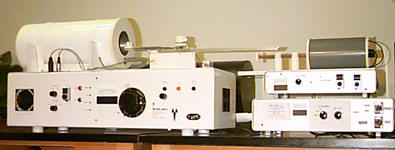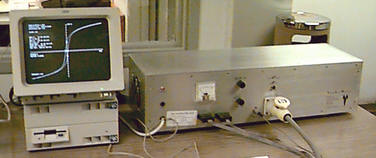 |
 |
|
THE
ROCK & MINERAL MAGNETISM Contract Services - Client
Oriented Research - Training
Earth Sciences
Department Dedicated to Preparing Geoscience Professionals for the 21st Century
|
![]()
|
|
|||||||||||||||||||||
|
A Versatile Geophysical Technology
As we owe much of our recent scientific advances to magnetic media for high fidelity storage and retrieval of information, we owe much of our recent advances in deciphering Earth history to Rock and Mineral Magnetism (RMM). Rocks are in every sense of the word the magnetic medium of the Earth, recording imprints of the events and processes that shaped the Earth throughout much of geologic time Magnetic mineral grains in rocks act as microscopic compasses that fossilize detail record of the ancient geomagnetic field. Whereas the "half-life" of a signal recorded on even the most advanced man-made magnetic medium is less than few tens of years, rocks are capable of preserving natural magnetic signals for several hundreds of millions of years. These signals can be retrieved, identified, separated and dated using the sophisticated techniques of Rock Magnetism and Paleomagnetism. Rock Magnetism has, over the past half century, matured into both a science and a technology. As a scientific endeavor, it is a branch of geophysical sciences concerned with the study of the magnetic properties of rocks and their constituent magnetic minerals. As a geophysical technology, it is undoubtedly, the most versatile addition to the geophysicist's arsenal of tools to probe earth's history. Applied rock magnetism (or Paleomagnetism) brings pure science to the problem-solving arena with adaptability to a wide range of problems including:
The source of these diverse applications is just a few magnetic mineral systems in rocks and the fact that the primary mix, composition and grain size of those minerals may not remain stable, but may change with source variation, or over time, as the result of secondary chemical, temperature or pressure events. These events can be recorded as a changed magnetic response and may be of broader geologic and economic significance. By understanding the source of the magnetic response of rocks, we gain a richer understanding of the geological events (often subtle and undetected by more mainstream methods) that have affected them. We get more out of the applications, and we can capitalize on the greater level of detail now being returned by more sophisticated data-acquisition instrumentation. Robust interpretations are underpinned by knowledge of the magnetic properties of the rocks studied |
![]()
|
|
|||||||||||
|
Unique of Its Type in the Gulf Region. The Rock and Mineral Magnetism Laboratory is part of the advanced research facilities of the Department of Earth Sciences at KFUPM. It was established in 1985 as a conventional paleomagnetic lab for investigation of Al-Harrat volcanic fields in eastern Saudi Arabia. Recently the lab has been upgraded and re-equipped for new focus on contract research and services in the areas of:
The laboratory is fully equipped with world-class instruments by standard-setting American and European manufacturers such as Schonstedt (USA), Magnetic Measurements (UK), Bartington (UK) and Molspin (UK). Supporting facilities include coring and sample preparation workshop and data processing and modeling computation unit. |
|
Molspin |
|
|
|
![]()
|
|
||||||||||||||||
|
World-Class in Integrity, Precision and Reliability
The laboratory is furnished with instruments that cover
the entire gamut of magnetic measurements necessary for complete magnetic
characterization of rock, mineral and soil samples. This includes measurements
and analyses of key magnetic parameters of samples at controlled low and high
temperatures and direct and alternating magnetic fields. The parameters measured
and analyzed include:
|
|
Schonstedt Digital Specimen Magnetometer A slow-spinner flux gate magnetometer with sensitivity range between 1.0 and 10-7 A/m; moment accuracy of ± 5% and angular accuracy of ± 1.5o. The instrument is computer - controlled under a data processing package. |
|
||||||||||
|
Minispin Portable Rock Magnetometer
A high sensitivity, slow-speed, fluxgate magnetometer, fully computer controlled with low noise level and compact size that gives it portability to be used either in the field or in the laboratory. It allows measurements of standard-size specimens (2.54 cm). Selectable integration-time of either 6 or 24 sec (24/120 spins). Noise-level is less than 10-5 A/m, and sensitivity better than 10-4 A/m. |
|
||||||||||
|
Shielded Alternating Field Demagnetizer This instrument enables rocks to be demagnetized by the alternating field method. The electronically-controlled field has a peak value of up to 1000 gauss (0.1T) at 180 Hz. The rock sample is held in a 2-axis tumbler; and the demagnetizer coil is shielded by a triple-walled Mu metal bucket shield. |
|
||||||||||
|
Thermal Magnetizer-Demagnetizer
Sophisticated programmable Heat/Hold/Cool cycle electrical furnace. Internal calibrated solenoid for applied fields up to 1.0 Oe. Shielded with 4 Mu-metal layers, closed at ends with automatic degaussing so that residual fields in chamber are < 10 nT (typically 2-3 nT). Fast cycle, 80 samples to 500 oC, 15 min hold at 500 deg C, cool to 40 deg C in less than 70 minutes. |
|
||||||||||
|
Anhysteretic Remanence Analyzer Allows Partial Anhysteretic Remanent Magnetization (PARM) of rock samples. This flexible system allows the position and range of the PARM field to be set anywhere on the demagnetizing cycle. The value of the PARM field (up to 1.0 Oe) is preset on a meter, and the field only comes on during the descending phase of the demagnetizing cycle. However a switch allows the field to remain on for the whole cycle if this is desired. In this mode the PARM becomes a standard ARM device. |
 |
||||||||||
|
Vibrating Sample Magnetometer (VSM) An instrument for measuring magnetic hysteresis cycles of rock samples. All the functions of the instrument are controlled by a computer, which sets the field, drives the vibrator, gathers the signal from the pickup coils and then stores and displays the hysteresis curve. The system combines advanced electronics and innovative design for rapid measurement and outstanding performance. The dynamic balancing of the system allowed the VSM high sensitivity of about 8.0 x 10-8 A m2, at a noise level of about 1.0 x 10-8 A m2 |
 |
||||||||||
|
Susceptibility Anisotropy Analyzer A fully integrated system for measuring both bulk and anisotropy of magnetic susceptibility (AMS) of rock sample. The sample is spun at 6 Hz about a vertical axis within two set of orthogonal source and pick-up Helmholtz coils. The magnitude and phase of the detected field is proportional to the magnitude and of the anisotropy of susceptibility. The phase sensitive signal is rectified and integrated over 6 sec or 24 sec and is Fourier analyzed. The sensitivity of the instrument is better than 10-1 G/Oe and its noise level is less than 3 x 10-8 , for the 24 sec spin |
|
||||||||||
|
Pulse Magnetizer This device may be used to induce an IRM into a rock sample by use of a pulse technique. Rock samples of 1 inch (25.4mm) diameter, and up to 1 inch (25.4mm) long may be subjected to fields up to 10,000 gauss (I.0 T). The power requirement is reduced to less than 100W by use of the pulse technique. |
|
||||||||||
|
Magnetic Susceptibility System The MS2 system is the international standard for the measurement of magnetic susceptibility in environmental sciences. The MS2 meter is a portable instrument with sensors for field and laboratory use. The system is used in geomorphology, geophysics, archaeology and mineral exploration. The MS2 is a versatile system with a range of individually calibrated sensors. It has a high resolution and accuracy, excellent temperature stability and very low measurement drift. It provides non destructive measurements and has a low operating frequency so measurements are not affected by sample conductivity. Readings are taken in around 1 second. |
|
||||||||||
|
Sensor Type MS2B This sensor accepts 10ml and 20ml cylindrical bottles, 25.4mm and 23mm cubic boxes, 35mm pots and 25.4mm cylindrical cores. A manually operated platen allows the sample to be inserted and positioned centrally within the sample cavity. The sensor is used for mass or volume specific susceptibility measurements of standard paleomagnetic samples in studies of rock and mineral magnetism. It is also used in conjunction with the AMS-BAR software and sample adaptor for measurements of the anisotropy of susceptibility. The unique dual frequency facility permits identification of ferrimagnetic grains close to the superparamagnetic stable single domain transition. This information is critical to many aspects of interpretation, for example in studies of weathering and soil formation, fossil soil identification and characterisation, and sediment or dust source investigations. In archaeology, precise measurements with this sensor confirm and enhance the evidence of ancient human occupation and land use obtained with the MS2 field sensors. |
|
||||||||||
|
Sensors Type MS2C A series of loop sensors, ranging from 36 to 162mm in diameter, is available for high resolution volume susceptibility measurements on whole cores. They are suitable for measuring any type of peat, lake or marine sediment core, provided it is not metal clad. As a result of their rugged construction these sensors are ideally suited for laboratory, field or shipboard use. Data obtained with these sensors are of great value in prospection, core correlation and multiple core studies and in identification of paleoclimatic sequences. Optimum measurement accuracy is achieved with 5-10mm core clearance. Calibration graphs are provided for intermediate core sizes. These sensors can be used with automated core analysis systems - details on request. |
|
||||||||||
|
Probe Type MS2F This miniature probe is ideal for the stratigraphic study of exposed geological and archaeological sections. It is also used where difficult surface conditions prevent good contact with the MS2D loop. The probe can only be operated in conjunction with the MS2 probe handle
|
|
||||||||||
|
Susceptibility/Temperature System This system is designed for the measurement of the magnetic susceptibility of 2.5ml samples over the temperature range -200°C to +900°C. It is used in the investigation of magnetic mineralogy and grain size and for the determination of Curie transition temperatures. The components of the system are:
|
|
![]()